ASUS PQ321Q UltraHD Monitor Review: Living with a 31.5-inch 4K Desktop Display
by Chris Heinonen on July 23, 2013 9:01 AM ESTUniformity is tested by using 25 locations across the screen and measuring the color checker chart at each of them. From there we can pull out contrast, black and white uniformity, and color uniformity. This review is the first to utilize the newest measurement available in CalMAN 5.1.2: dE From Center. Now instead of measuring the dE2000 at every location, we measure it relative to the center measurement.
This gives us a true uniformity measure. I could measure the left side and the right side of the monitor and get a dE2000 of 2.0 for each side. What that doesn’t tell me is that the left side might be red tinted, and the right side blue tinted, while the center might be green tinted. In this case they could all measure the same dE2000, but look totally different. By comparing the measured values to the center, we get an actual measurement of if one area of the screen will look the same as another area. Since we always use the center of the screen as our calibration target, which is why everything is measured relative to that.
Starting out with White Uniformity, we see decent but not amazing results. The panel stays within +/- 10% for the center, but falls down to a 17% variation at the edges. The light fall-off is relatively high, and makes me wonder if the look of the panel, and its thin design, might place a bit of emphasis on style over substance.
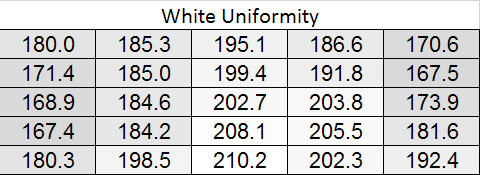

With the black level charts we see similar results. The middle of the panel is +/- 10% again, but the edges fall off to a nearly 20% difference. There is a curious rise in black level in one measure where there was a fall-off in white level, but otherwise the results between the two measurements are similar.
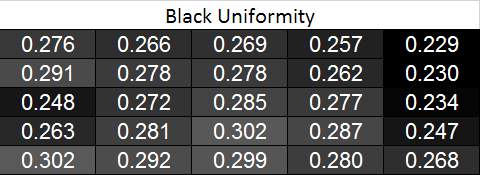
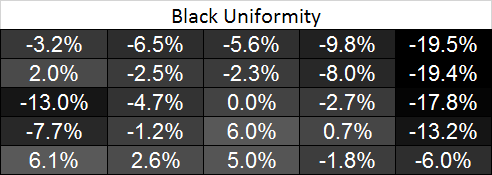
Looking at the resulting contrast, the numbers here are much closer to 100%, which we expect to see. Areas with light fall-off affect the white and black levels almost equally, so the contrast ratios are very similar all across the screen. That gives us a 700:1 expected contrast ratio for the screen as a whole.
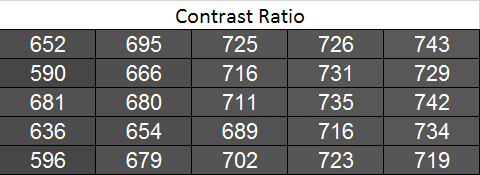
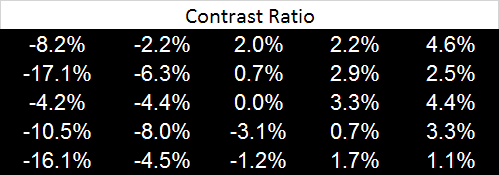
Now we can see the new dE2000 From Center data. The issues here crop up at the outsides of the screen, where we see the backlighting issues earlier. Uneven lighting is the issue most likely to cause color issues on the screen, and that is certainly backed up here. In the center of the screen, you are going to not see a difference in colors when you look directly at the screen. With a light loss of less than 10%, and a color dE2000 of <2 for most of the center screen, everything will look identical. As you get to the extreme edges you will run into more issues. I will need more monitors to be tested with this new method, but I think this is going to wind up as a good result in the end.

Going with an LED lighting system, and not a backlit array one, is always a bit of a concern for me. Overall the PQ321Q does well for uniformity for using one, and it avoids some of the massive issues we have seen with some LED systems before. But we are looking for near-perfection from the ASUS and it can’t quite do that. The center 60% of the screen is excellent overall, and for most people that will mean you may not notice these issues at all, but they are there.










166 Comments
View All Comments
DanNeely - Thursday, July 25, 2013 - link
Probably never since margins are higher on 16:9 screens; a 21" 2560x1440 screen could be made from the same line just by cutting the panels smaller.In that general size bucket though I'd like to see them jump directly to 4k too though for ~200DPI. This is high enough to make AA mostly unneeded when gaming and to allow for 2:1 scaling for legacy apps.
jasonelmore - Wednesday, July 24, 2013 - link
UHD or 4k is gonna be good for the living room simply because TV's will get bigger, and that's where 4k really shines.Back in the day, i remember 32" was massive. Then when HD first came out, 42" was the standard when talking about big screens. Now 55" is the new standard, and 70 inch will probably be common place in the next couple of years. 4k on a 70 inch will look great.
DanNeely - Thursday, July 25, 2013 - link
Maybe. 70/80" TVs require rearranging your living room in ways that smaller sizes don't; and take up enough space that in smaller houses they've often impossible just because you don't have any blank wall sections that big that you can orient furniture around.yhselp - Wednesday, July 24, 2013 - link
PixPerAn FeedbackThe PixPerAn test looks great, you’ve done nothing wrong; on the contrary, the idea is to show the realistic best and worst case scenario out of which the former should be more representative for most users. However, some of your results, namely pictures 2 and 3, seem very optimistic. In my opinion, and from my experience, pictures 4 and 5 show the real best (4) and worst (5) case scenarios. How did you capture the results and under what settings? I could try to replicate the test on my U2311H and compare the results to those that I did when I purchased the monitor and upload the results.
It might be a good idea the crop the relevant pictures (those above), pick out two that are most representative for relevant best and worst case scenarios and create a single picture instead of a gallery. If you decide that more cases should be shown that’s perfectly alright, but an organized single picture would still be easier to read. Also, some context for readers unfamiliar with what this test shows and how to read it would be quite useful.
It’s a common misconception that monitors with higher response time than 2ms are not fast enough. Believe it or not, a lot of people, especially gamers, steer clear of monitors with higher response time. In reality things are much different; the ms rating alone says little. Not all response time ratings are created equal. One might write an article solely about the response time of a monitor, however, without going into technicalities such as RTC, PixPerAn can give an easy to read and understand representation of what a user can actually expect to experience in terms of RT in a monitor. For example, a lighter ghost image or a pale overshoot behind the moving car is usually harder to spot in actual use. PixPerAn is also good for testing stereoscopic 3D ghosting and S3D performance in general; you can clearly see the benefits of NVIDIA LightBoost in the test.
A picture is worth a thousand words, especially in this case. Just by looking at a PixPerAn result you can derive almost everything you need to know about how fast a monitor should actually feel like (and what kind of visual artifacts you might experience). I would be really glad if you make this test standard on all your future monitor reviews, at least here on AnandTech. It wouldn’t take much space in the reviews and should be relatively quick to take. Please, let me know whether you think it’s a useful test, etc.
Thank you for the great review.
sheh - Wednesday, July 24, 2013 - link
3D graphs of response times for all combinations of start/end pixel lightnesses, which were in Xbitlabs reviews, are also interesting.DesktopMan - Wednesday, July 24, 2013 - link
Response time: 8ms GTGEveryone who writes about Igzo (including Chris in this article) talks about how Igzo allows for higher electron mobility which makes a faster display. Then why is the GTG this bad?
Does it do 1080p@120hz? Might not matter if it really is this slow though.
ChristianLG - Wednesday, July 24, 2013 - link
Hello. ¿Why the monitor you are reviewing isn’t a true 4k monitor? ¿ What is a true 4k monitor? Thanks.cheinonen - Friday, July 26, 2013 - link
True 4K, when it comes to digital cinema, is 4096 pixels wide, but the height can vary depending on the content. Since this is only 3840 pixels wide, it falls under the UHD heading, but everyone uses 4K anyway because it sounds good.joshu zh - Wednesday, July 24, 2013 - link
You can find 4K TV in stores now. I can see clearly the difference between 1080P and 4K. You should try it and you may change you thoughts about 4K TV. To me, the issue is you could not find enough 4K materials to watch now. I hope this situation will change in 2-3 years.Sabresiberian - Wednesday, July 24, 2013 - link
One of my "pet peeves" is the fact that the display industry goes out of its way to blur the monitor/TV line. They aren't the same, and selling them as though they were is disingenuous at best. It has given us a 16:9 standard where it doesn't belong - and now we are crashing up against the limits of standards essentially made with low-res and TV in mind.Putting speakers in a $3500 display is like putting a $5 tuner in a Marantz amplifier. Certainly if I have the money to pay for one of these things I'm not going to put up with crap for speakers! It is just about as useless a thing as can be done.
I think the best thing I can say about this monitor is that finally someone has broken the ice, and I give Asus a lot of credit for that. Not saying it's bad, just saying for $3500 I'd like to have seen more polish (better OSD) and better calibrated performance. Nice job Asus, but you could have done better.